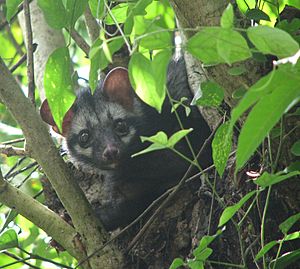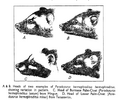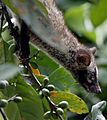Asian palm civet facts for kids
Quick facts for kids Asian palm civet |
|
|---|---|
 |
|
| Conservation status | |
| Scientific classification | |
| Genus: |
Paradoxurus
|
| Species: |
hermaphroditus
|
 |
|
| Asian palm civet range: native in green, introduced in red | |
The Asian palm civet (Paradoxurus hermaphroditus) is a small, furry animal. It is part of the viverrid family, which includes animals like mongooses and genets. These civets live in South and Southeast Asia.
Scientists consider the Asian palm civet a "Least Concern" species. This means it is not currently in danger of disappearing. However, in some places like Indonesia, these civets face threats. People sometimes illegally hunt them or buy and sell them. This often happens because some people use them to make a special kind of coffee called kopi luwak. The civets eat the coffee beans, and the beans are collected after they pass through the civet's digestive system.
Contents
What is an Asian Palm Civet?
The Asian palm civet is a mammal that looks a bit like a cat or a weasel. It has a long body, short legs, and a long, bushy tail. Their fur is usually dark gray or black, often with some lighter spots or stripes. They have a pointed snout and small, rounded ears.
Where Do Asian Palm Civets Live?
Asian palm civets are found across a wide area in Asia. Their natural home includes countries like India, Sri Lanka, Nepal, Bangladesh, Myanmar, Thailand, Malaysia, Singapore, Indonesia, and the Philippines. They can live in many different places, from forests to even near human towns.
What Do Asian Palm Civets Eat?
Asian palm civets are omnivores, which means they eat both plants and animals. Their diet includes fruits like mangoes and coffee cherries. They also enjoy insects, small rodents, and even birds. Sometimes, they eat tree sap or nectar from flowers.
Life and Habits of the Civet
Asian palm civets are mostly active at night. They are good climbers and spend a lot of time in trees. They use their long tails to help them balance as they move through branches. During the day, they usually rest in tree hollows or thick bushes.
How Do Civets Communicate?
These civets use different sounds to talk to each other. They might make growls, hisses, or even a soft purring sound. They also use scent marks to communicate. They have special glands that produce a strong smell, which they use to mark their territory or show their presence to other civets.
Baby Civets and Their Families
Female Asian palm civets usually give birth to one to four babies at a time. The babies are called pups. They are born blind and helpless, and their mother takes care of them in a safe den. The pups grow quickly and learn to climb and find food from their mother.
Conservation of the Asian Palm Civet
Even though the Asian palm civet is a "Least Concern" species overall, some local populations face challenges. The biggest threat is the illegal trade for kopi luwak coffee. Civets are often kept in small, unhealthy cages for this purpose, which is not good for their well-being.
Protecting Civets from Illegal Trade
Many people are working to stop the illegal capture and trade of Asian palm civets. They educate people about the importance of protecting these animals in their natural homes. Choosing not to buy kopi luwak coffee that comes from caged civets can also help protect them.
Images for kids
-
An Asian palm civet captured in a compound in Kerala
See also
 In Spanish: Civeta de las palmeras común para niños
In Spanish: Civeta de las palmeras común para niños











